Hydrometallurgy Laboratory
About
The Hydrometallurgy Lab at the Memorial University of Newfoundland consists of a wide variety of equipment that contributes to a number of research activities that include:
- Analyzing the interaction between mineral surface and flotation reagents;
- Studying the bonding mechanism between metal ions and complexing ligands in solvent extraction and ion exchange processes;
- Organic compounds identification.
- Measuring the zeta potential of minerals / solid particles
- Measuring the adsorption amount of organic compounds on mineral/solid surfaces.
- Evaluation of mineral ores.
- Process mineralogy study on grinding products, tailings and concentrates of mineral processing and hydrometallurgy dregs to improve mineral or metal recovery.
- Measuring concentrations of metal ions in aqueous solutions.
- Materials corrosion
- Alloy film/metal powder electrodeposition
- Electrochemical mechanism of sulphide minerals flotation
- Microstructure characterization of materials and minerals in ores
People
- Dr. Yahui Zhang
- Mineral Processing
- Hydrometallurgy
- Chemistry of Materials
- Dr. Yan Zhang
- Energy
- Green Engineering
- Process System
- Simulation
- Dr. Kelly Hawboldt
- Green Processing of Natural Resources
- Biofuels
- Natural Gas Processing
- Dr. Lesley Anne James
- Enhanced Oil Recovery
- Improved Oil Recovery
- Phase Behaviour
- Offshore Oil & Gas
- Process Engineering
- Process Equipment Design
- Business Process Engineering
- Dr. Sohrab Zendehboudi
- Energy and Environment
- Process Systems Engineering
- Transport Phenomena
- Carbon Capture, Utilization, and Sequestration
- Reservoir Analysis
- Dr. Faisal Khan
- Green Engineering
- Mineral Processing
- Offshore and marine safety
- Safety and Risk
Equipment
Mineral-Flotation Reagent Interaction Analyses
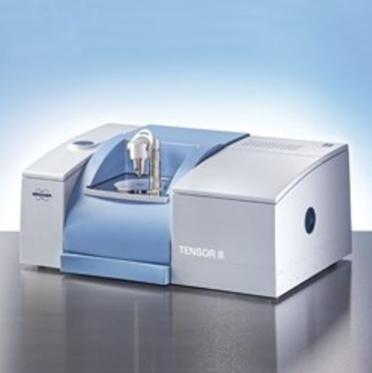
The TENSOR II is the first R&D FTIR using a diode laser with a much longer hold time than HeNe-lasers included in conventional R&D FTIR instrumentation. The IR-source in the TENSOR II is electronically stabilized to accomplish much longer exposure times than before. Another innovation is the new electronic platform with expanded functionality which provides a further increase in stability for the TENSOR II against mechanical disturbances and vibrations.
Specifications:
- Highest sensitivity by the permanently aligned Rock Solid interferometer and Digitect 24bit ADC detector technology
- Continuous control of performance
- Diode laser with long lifetime
- Electronically stabilized IR source for long lifetime
- Power mode for low-intensity applications with DTGS detectors
- Fully automated validation according to cGMP (operational qualification, PQ)
- Software OPUS is compliant with 21CFRp11, and validation according to the US, European and Japanese Pharmacopeia using integrated NIST traceable standards available for the instrument.
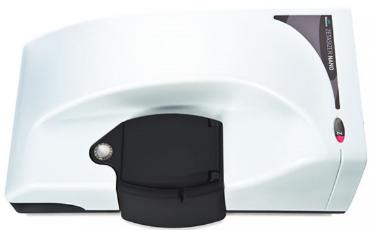
Specifications:
- Zeta potential using patented M3-PALS technology.
- A 'Quality Factor' and 'Expert Advice System give the confidence of having an expert at your shoulder.
- 21CFR part 11 software option to enable compliance with ER/ES.
- Research software option to give access to further features and analysis algorithms for the light scattering specialist.
- Automation of measurements using an auto titrator option.
- Alternative laser, 50mW at 532nm for samples incompatible with the standard 633nm laser.
- Optical filter option to improve measurements with the fluorescent sample.
- Temperature range extension option to 120°C.
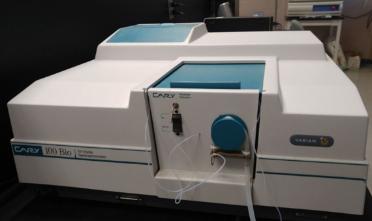
The Cary 100 Bio has excellent temperature control. The temperature-controlled single or multicell peliter thermostatted cell holders offer:
- Excellent stability control over time (typical variation ±0.05 °C)•Minimal cell-to-cell variation (maximum difference, 0.2 °C at 37 °C)
- Accurately measure the temperature of the actual sample within the cuvette using temperature probes
- In-built electromagnetic stirring providing complete control of the stirring speed, with no fluctuations (up to 12 cells)
- Superior multi- and single-cell peltier temperature control allows temperature ramp rates as slow as 0.06 °C/min to be selected for high-resolution DNA and protein thermal melting experiments.
Specifications:
- Applications: Scanning / Kinetics / RNA/DNA / Concentration / Simple Reads / Validation
- Detection: R928 PMT
- Format: Single-Beam
- Type: UV/Vis
- Accuracy: +/- 2 nm
- Wavelength(s): 190 to 900 nm
- Light Source: Tungsten Halogen
Mineral Liberation Analyzer (MLA) for Process Mineralogy Study
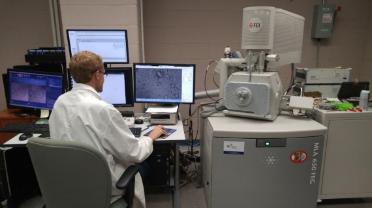
The Scanning Electron Microscopy Lab contains two SEMs: the FEI Quanta 400(1), for serving general applications in biology, chemistry, mineralogy, and physics, and the FEI MLA 650 FEG (2), which are equipped with sophisticated MLA software that allows quantitative evaluation n of abundances, associations, sizes and shapes of minerals in an automated systematic fashion.
Specifications:
- The SEMs are equipped with high throughput Energy-dispersive X-ray spectroscopy (EDX) detectors from Bruker. Both SEMs are also capable of x-ray aided image analysis, i.e., Mineral Liberation Analysis® (MLA).
- The MLA software automates image acquisition, stage movement and x-ray acquisition for spatially quantifying mineral abundances.
- The MLA 650FEG is also equipped with an electron backscatter diffraction (EBSD) system from Oxford/HKL.
- Both SEMs are capable of environmental SEM (ESEM), which refers to the SEM's capability of working at variable pressures or near atmospheric pressures instead of being limited to high vacuum. ESEM also allows for almost any specimen to be examined, including wet and non-conducting specimens.
XRF for Metal Ion Concentration Analysis
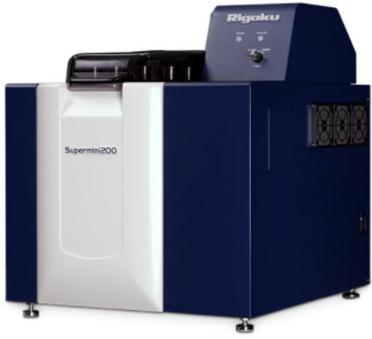
Rigaku Supermini200 offers superior fundamental parameters and empirical software capabilities in a high-resolution instrument with a compact footprint. As a high-power benchtop sequential wavelength dispersive X-ray fluorescence (WDXRF) spectrometer, for elemental analysis of oxygen (O) through uranium (U) in almost any material.
Specifications:
- Analyze oxygen through uranium (O → U)
- Analyze solids, liquids, powders, alloys and thin films
- Atmosphere: helium or vacuum
- X-ray tube: 50 kV, 200 W Pd-anode
- Primary beam filter: Zr is standard; Al optional
- Detectors: scintillation counter and F-PC
- (S-PC not requiring P10 gas optionally available)
- Crystals: 3-position changer
- Sample size: able to accommodate 51.5 mm diameter samples
- Automatic sample changer (ASC)
- Standard: 10 sample positions (for 51.5 mm diameter samples)
- Optional: 12 sample positions (up to 44mm diameter samples)
- Vacuum: rotary pump standard
- Power: 100 – 120V (50/60 Hz) 15A or 200 – 240V (50/60 Hz) 10A
Electrochemical Workstation for Studies in Corrosion, Film Preparation, Hydrometallurgy, and Sulfide Mineral Flotation
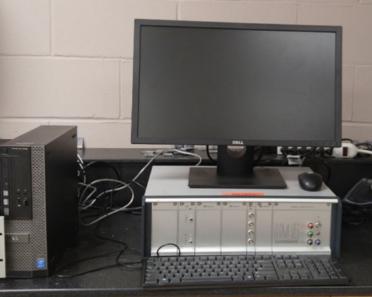
Specifications:
- Impedance spectroscopy
- Cyclic voltammetry
- Polarization curves
- Electrochemical noise analysis
- Capacity/potential measurements
- Multi-cell voltammetry
- Arbitrary current/potential/time acquisition
- High current applications
- Automatic series measurements
- Simulation & fitting
- Transient recording
- Acquisition of time-domain data
- Integrated CAD and word processing software and many other acquisition & analysis methods
Microstructure Analysis of Materials and Minerals in Ores
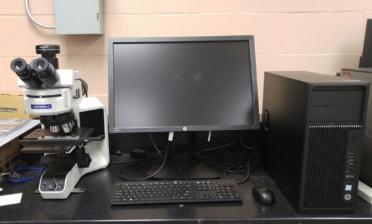
- The Invisible Becomes Visible
- Create All-in-focus Images
- Easily Move the Stage for Panorama
- Capture Both Bright and Dark Areas
- Adaptable to Suit Observational and Analysis Preferences
- Accommodates a Wide Range of Samples
OLYMPUS Stream image analysis software offers fast, efficient inspection workflows for all process steps for image acquisition, quantitative measurements and image analysis, reporting, and advanced materials science inspections tasks.
Specifications:
- High colour rendering index more precisely reproduces purple, pink, and cyan hues
- High luminosity LED Brighter than 100W halogen lamp
- Long Lifetime of 50,000 hours
- Multi-Discussion Observation up to 26 viewers
Location
IIC 1028J, IIC 1037, IIC 1018,
Bruneau Centre
Memorial University of Newfoundland
St. John's, NL